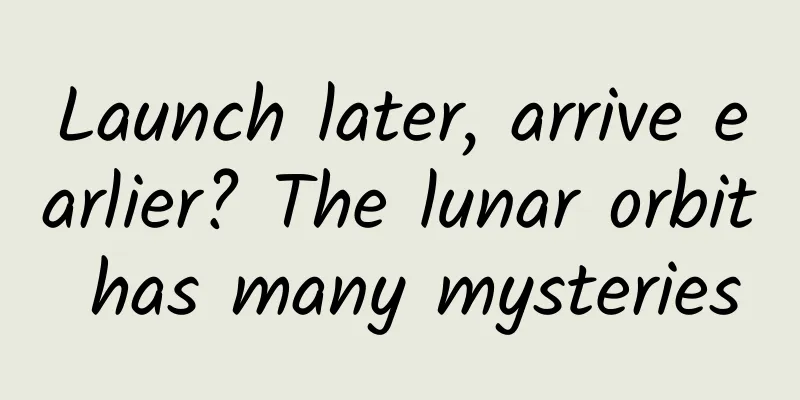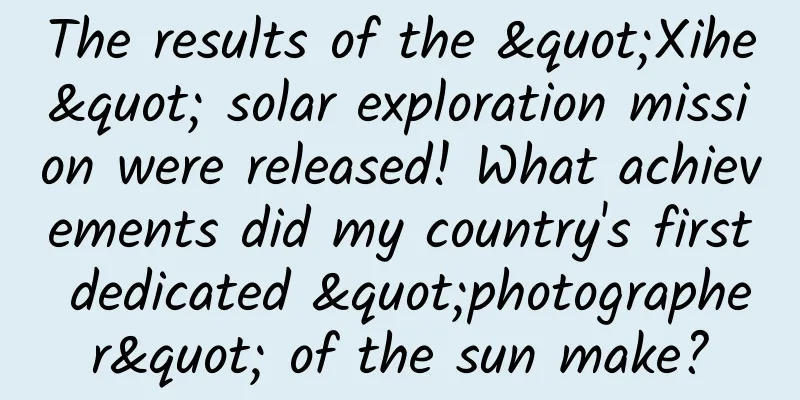Launch later, arrive earlier? The lunar orbit has many mysteries

|
On July 25, India's Chandrayaan-3 probe completed its fifth Earth orbit ascent and is expected to enter the Earth-Moon transfer orbit on August 1, with a chance of landing on the moon on August 23. In addition, Russia plans to launch the Chandrayaan-25 probe on August 11, which is expected to land on the moon on August 21. The Russian probe was launched nearly a month later than the Indian probe, so why is it expected to land on the moon earlier? What factors affect the spacecraft's choice of lunar exploration orbit? What mysteries do different lunar exploration orbits contain? “Scramble” to grab the record On July 14, the Indian Space Organization launched the Chandrayaan-3 probe into space using the LVM3 rocket at the Satish Dhawan Space Center. The launch mass of Chandrayaan-3 is about 3.9 tons, including the propulsion module, lander and lunar rover. Among them, the propulsion module weighs more than 2 tons and is responsible for sending the lander and lunar rover to the lunar orbit at an altitude of 100 kilometers; the lander weighs about 1.75 tons and uses four 800-newton variable thrust engines; the lunar rover weighs 26 kilograms and is planned to roam in the south pole of the moon.
The Indian side claimed that "Chandrayaan-3" cost about 73 million US dollars, has a design life of 14 days, and will achieve three major goals: verify the technology of safe soft landing on the lunar surface, patrol the moon, and conduct in-situ scientific experiments on the moon. If Russia had not "overtaken at a short distance", India would have become the fourth country to achieve a soft landing of a spacecraft on the moon and the first country to land in the south pole of the moon. Unfortunately, India's journey to the moon has not been smooth sailing. For example, LVM3 is India's most powerful rocket, but its carrying capacity to the Earth-Moon transfer orbit is only about 2 tons, and it cannot directly send Chandrayaan-3 into the Earth-Moon transfer orbit. Therefore, "Chang'e3" first entered the phase adjustment stage of flying around the earth, and through five large elliptical orbit maneuvers, it gradually raised the apogee of the Earth's orbit so as to enter the Earth-Moon transfer orbit. The trouble is that Chandrayaan-3 did not enter orbit smoothly in its initial stages: according to the plan, it should have initially entered an elliptical orbit with a perigee of 170 kilometers and an apogee of 36,500 kilometers; due to insufficient orbital insertion accuracy, Chandrayaan-3 entered an orbit with a perigee of 138 kilometers and an apogee of 36,300 kilometers. The perigee altitude was 32 kilometers lower than expected, which seemed unsafe. The Indian Space Organization urgently carried out a series of orbit changes. Fortunately, after five orbit changes, the orbital altitude of Chandrayaan-3 has returned to normal and is preparing to enter the Earth-Moon transfer orbit. If the probe reaches the moon as scheduled on August 23 and lands at an appropriate time, the entire journey to the moon will last 40 days.
However, in the eyes of Russian space experts, Chandrayaan-3 is a case of "getting up early and arriving late". Russia's Luna 25 probe is scheduled to be launched on August 11. Since the launch of Luna 24 in 1976, Russia has once again explored the moon half a century ago. It also plans to land in the lunar south pole to search for traces of water ice and conduct dust plasma research in the lunar polar exosphere. In addition, another important goal of "Luna 25" is to "train" Russia's deep space exploration and lunar exploration engineering system, thereby integrating aerospace technology resources, cultivating and training a team of talents, and laying the foundation for subsequent lunar exploration and even the establishment of a lunar base. Thanks to the stronger carrying capacity of Russian rockets and the launch mass of "Luna 25" of only 1.75 tons, the probe will directly enter the Earth-Moon transfer orbit and is expected to orbit the moon around August 17 and land on the moon on August 21. In this way, India and Russia will strive for the world record of the first landing in the South Pole region of the moon. Russia's Luna 25 is being tested at the Vostochny Cosmodrome Clever selection of lunar exploration path By simply comparing India and Russia's lunar exploration missions, we can find that their lunar exploration paths and their impacts are very different. In fact, lunar exploration includes hard landing, soft landing, and lunar orbit. Combined with specific tasks, the lunar exploration flight orbit is roughly composed of five interconnected segments: launch, phase adjustment, Earth-Moon transfer, lunar circumnavigation, and landing on the moon. Among them, the Earth-Moon transfer orbit is very critical, and it is the most convenient path for the probe to fly from the Earth to the Moon. The perigee and apogee of this orbit are tangent to the parking orbit of the probe around the Earth and the lunar orbit respectively, which allows the probe to reach the perigee after about 4 days of flight, and then "brake" into the lunar gravitational field and be captured by the moon. Looking at the lunar exploration activities of various countries, the probes mainly choose two routes. The first is the phased multiple orbit entry, that is, the rocket sends the probe into a large elliptical orbit around the earth, and then the probe accelerates to enter the Earth-Moon transfer orbit and then flies to the moon. The "subtext" of this choice is generally that the rocket's carrying capacity is insufficient, and it is mostly used for unmanned lunar exploration missions. According to public information, my country's Chang'e-1 probe chose this way to fly to the moon. The Long March 3A rocket sent the probe into a large elliptical orbit around the earth with a perigee of 200 kilometers and an apogee of 51,000 kilometers. The probe then changed orbits four times and entered the Earth-Moon transfer orbit. After flying for more than 100 hours, it reached the perigee. It is not difficult to see that in this mode, the probe has multiple opportunities to adjust its orbit and try to eliminate errors caused by launch and other factors. Each time the orbit change is initiated, the position of the probe relative to the earth remains basically unchanged, making it easier for the ground team to monitor the orbit change process. However, this mode undoubtedly prolongs the flight time of the probe, which is not conducive to manned lunar exploration activities. The second is direct orbital entry, that is, the rocket directly sends the probe into the Earth-Moon transfer orbit. For example, my country's Chang'e 2 probe was launched by the Long March 3C rocket and directly entered the Earth-Moon transfer orbit, significantly shortening the time to reach the moon. Since then, my country has chosen this mode for all its lunar exploration activities. This method can shorten the probe's flight time and save fuel, but it places high demands on the distribution of the measurement and control network, command and communication, rocket carrying capacity, and orbital accuracy. Theoretically, if the probe has a speed error of 1 meter per second or an altitude error of 1 kilometer when entering the Earth-Moon transfer orbit, the position error can reach thousands of kilometers when it reaches the vicinity of the moon. In the US Apollo Program, manned spacecraft also entered the Earth-Moon transfer orbit directly, but chose the so-called "free return orbit" in the shape of a figure "8" to improve mission reliability: if the deceleration effect of the spacecraft is not good when it reaches the moon, it can automatically return to Earth. This orbit design played a significant role in the Apollo 13 mission. At that time, the spacecraft suffered a series of failures in space, including insufficient oxygen supply and main engine shutdown. With the help of the ground control center, the astronauts successfully "pushed" the spacecraft to a free return orbit and returned safely. Track optimization has broad prospects The Earth-Moon transfer orbit is the shortest flight path between the Earth and the Moon, but it requires a very high speed for the spacecraft to enter the orbit. Whether it is a direct launch or a phased multi-circle orbit, the probe needs to have a speed increment of about 500 meters per second to enter the Earth-Moon transfer orbit, which consumes considerable energy. In 1990, Japan launched the Hiten lunar probe, which for the first time used the so-called "ballistic lunar transfer orbit" to explore a lunar orbit with lower energy consumption. At that time, the probe was first launched by a rocket to the vicinity of the moon, and then with the assistance of the moon's gravity, it was made to fly in the opposite direction and to a place about 1.5 million kilometers from the earth on the sun-earth line. Then, with the help of the sun's gravity, the direction of the probe's speed was changed, reducing the speed increment required for the probe to enter orbit. This method of lunar exploration takes a long time, usually 3 to 4 months, and has high requirements for measurement and control, so it is more suitable for small lunar probes that do not carry much fuel. The European Space Agency's SMART-1 probe in 2004, the US Capstone probe in 2022, and the South Korean Hyungwol probe all adopted this type of orbit. In recent years, the tide of lunar exploration has surged in various countries, and exploring and designing new lunar exploration orbits is the general trend. In the US "Artemis-1" mission, the Orion spacecraft conducted an unmanned lunar flight test and entered a large-scale retrograde orbit 64,000 kilometers from the lunar surface. This type of cis-moon space orbit has the characteristics of long-term stability and low orbital energy, and is expected to operate as a transit station for manned lunar/Mars missions in the future. According to public reports, after my country's Chang'e-5 orbiter completed the lunar sample return mission, it carried out a series of expansion experiments, including orbital test missions, and entered a large-amplitude retrograde orbit around the moon. In the future, similar orbits combined with free return orbits are expected to significantly improve the mission reliability of manned spacecraft and unmanned probes. In short, the design of lunar exploration orbit needs to be based on the specific situation of the mission, including the capabilities of transportation, measurement and control, and the probe's own maneuverability, and comprehensively consider the probe's flight planning, fuel budget, etc. During the probe development stage, it is necessary to consider the needs of the onboard subsystem, analyze the orbit characteristics, optimize the flight process, complete the preliminary orbit design, and consider the possibility of fault plans and extended missions. The lunar exploration mission is a popular project in the current international space program, but many probes have failed to reach their goal, proving that it still contains high risks and great challenges. Human beings will continue to explore space, and I believe that more optimized orbits will be explored by lunar exploration spacecraft to better serve mankind. (Author: Yang Shirui, Image source: Indian Space Organization, Russian State Space Corporation, Reviewer: Jiang Fan, Deputy Director of the Science and Technology Committee of China Aerospace Science and Technology Corporation) |
<<: Why is China's 5,000 years of history not just a legend?
Recommend
Trend Li Gongzi Practical Training Camp (Phase II)
Resource introduction of Trend Li Gongzi Practica...
Will GitHub's App be open source?
As early as the GitHub Universe conference in 201...
How can event operation and promotion improve user conversion?
Many operators may have encountered this conversi...
More strange knowledge: not all squirrels are vegetarians!
Produced by: Science Popularization China Author:...
"DIY water" is popular, but some people drank it and ended up in the hospital! The doctor said...
Recently, the first cup of "DIY water" ...
Faraday Future has not yet finalized its financing and notified employees to continue to be on unpaid leave
According to foreign media reports, an internal e...
The Matrix "brain tube" technology demonstration: you can control the mouse with your mind
Two studies from Stanford University and the Univ...
The product manager of NetEase Cloud Music personally tells: practical experience in each product development stage of Cloud Music!
The topic I want to share with you today is "...
Satellite cloud images help you understand the weather: "Northeast Cold Vortex" is in the shape of a vortex! Does "arc-shaped cloud line" mean severe convective weather?
Northeast Cold Vortex The Northeast Cold Vortex i...
Look at the product growth of WeChat Reading through the AARRR growth model!
As we enter the second half of the mobile Interne...
These magical stripes have ruined countless photos, but they can also be so beautiful!
This magical stripe has ruined countless photos, ...
“Distant” and “near” marketing: What do you want consumers to pay attention to in your product?
For consumers, the author of this article propose...
Did the moon fall really happen?
There is a disaster movie called "Moonfall&q...
Must read! Case study of adding fans in the industry. It is not a problem to attract 10,000 fans a day~
A student who has just switched to information fl...





![[Case] UHome Hotel Operation and Promotion Case](/upload/images/67cc3e71c1103.webp)



